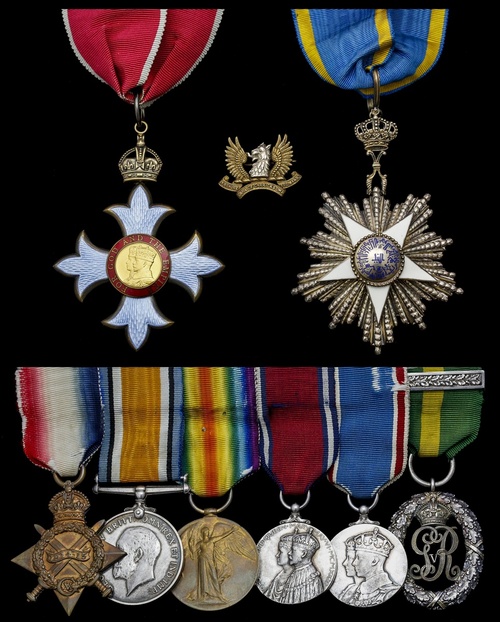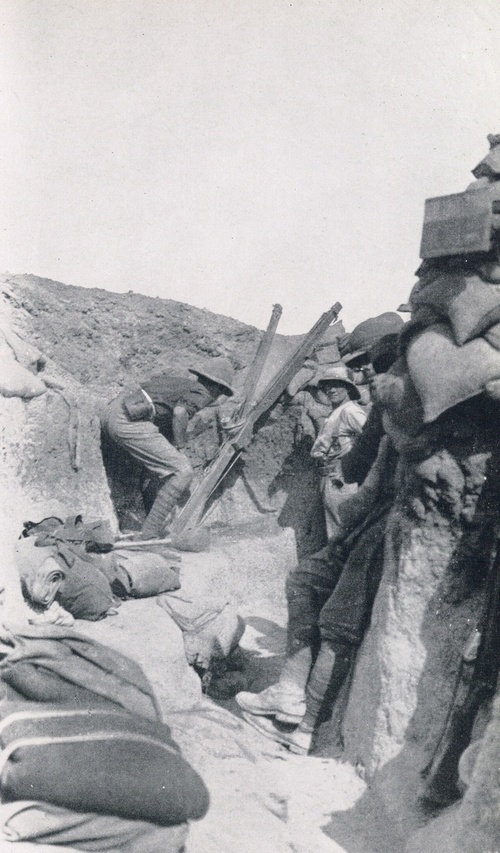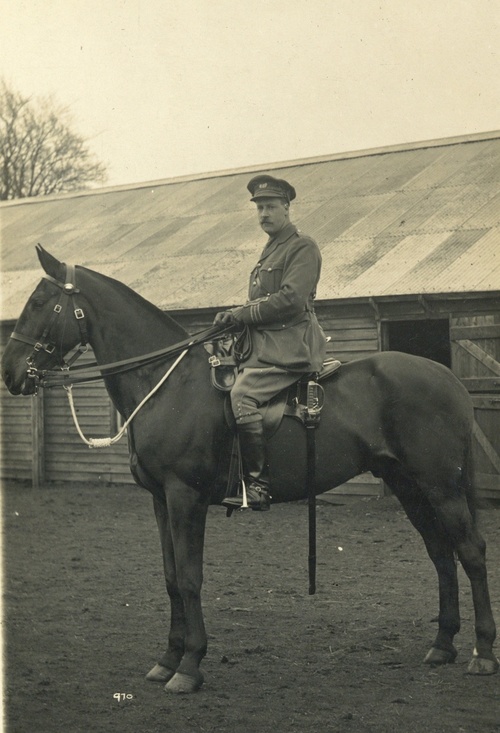Auction: 17003 - Orders, Decorations and Medals
Lot: 688
(x) 'Major Houldsworth, half buried in earth after a shell exploded on the lip of his trench, tried to make a report to the Adjutant, Captain Dubs, on the telephone, but it was difficult to make himself heard above the din. After half an hour, the bombardment suddenly ceased, leaving a vast cloud of evil-smelling smoke. This was so dense that some suspected gas, as it was related that the M.O., Captain Simpson, had been seen running about at H.Q. dressed only in a shirt and a gasmask … '
High drama in Palestine with the 12th (Ayr and Lanark Yeomanry) Battalion in May 1917; The Proud Trooper, by Major W. Steel Brownlie, M.C., T.D., refers.
A fine post-war C.B.E. group of eight awarded to Hon. Colonel Sir William Houldsworth, Bt., a Gallipoli veteran of the 1/1st Ayrshire Yeomanry who rose to the command of the 12th (Ayr and Lanark Yeomanry) Battalion in the Palestine operations 1917-18: it was a gallant tenure of command - vividly recounted in the pages of The Proud Trooper - and marked by several close brushes with enemy shell fire and a head wound that he swept aside in his eagerness to get back in the thick of it
The Most Excellent Order of the British Empire, C.B.E. (Civil), Commander's 2nd type neck badge, silver-gilt and enamel, in its Garrard & Co. case of issue; 1914-15 Star (Major W. T. R. Houldsworth, Ayr. Yeo.); British War and Victory Medals (Lt. Col. W. T. R. Houldsworth); Jubilee 1935; Coronation 1937; Territorial Decoration, G.V.R., hallmarks for London 1917; Egypt, Order of the Nile, Third Class neck badge, by Lattes, silver, silver-gilt and enamel, together with the recipient's identity discs and related Ayrshire (Earl of Carrick's Own) Yeomanry badge, the Victory fitted with a large type suspension ring, generally very fine (9)
C.B.E. London Gazette 1 January 1946.
William Thomas Reginald Houldsworth was born on 24 August 1874, the son of Sir William Henry Houldsworth, Bt., and was educated at Eton and Christ Church, Oxford.
His father had purchased farmland by the Stockport Branch Canal in Reddish in the early 1860s, where he built Reddish Mill, then the largest cotton-spinning mill in the world; it was followed by the North and Middle Mills in the 1870s, together with a model village. He later served as a Tory M.P. for Manchester (1883-85) and the N.W. Division of Manchester (1885-1906).
Young William was commissioned 2nd Lieutenant in the Ayrshire (Earl of Carrick's Own) Yeomanry Cavalry in March 1898 and gained advancement to Lieutenant in July 1900. He did not witness active service in South Africa and was appointed a Captain in June 1905, by which date the Ayrshire Yeomanry formed part of the Imperial Yeomanry.
Gallipoli: baptism of fire
Later still allocated to the Territorial Force - and following Houldsworth's advancement to Major in November 1909 and his appointment to the command of 'C' Squadron - the 1/1st Ayrshire Yeomanry landed at Cape Helles, Gallipoli in October 1915, on attachment to 52nd (Lowland) Brigade. Having then undertaken a period of training with the 1/4th Royal Scots Fusiliers in the 'Vineyard' sector, the regiment went into action at 'Hope Street' in early November, when it took and held valuable ground: part of the captured line was duly named 'Carrick Street'. Of this action, Houldsworth wrote in his diary:
'Occasionally the word was passed down, 'stretcher bearers wanted', and shortly afterwards a little party would return bearing the stretcher with its human load. This was the first fight in which we had taken a part, and nothing perhaps brought home the grim reality of it all than when I would see a procession pass by, or when walking along the line I would come across the lifeless form of some poor fellow laid out on the firing step awaiting removal, the bloodstains on the blanket in which he was wrapped standing out conspicuously in the pale light of the moon … '
Withdrawn from the peninsula at the end of December, and having suffered further casualties during a heavy Turkish bombardment in the same month, the 1/1st Ayrshire Yeomanry was amalgamated into the 12th (Ayr and Lanark Yeomanry) Battalion, Royal Scots Fusiliers, in which capacity it was attached to the Egyptian Expeditionary Force.
Palestine - opening shots
Houldsworth, who took command of 'A' Company, subsequently saw extensive action in the Palestine operations. An early case in point would be the occasion his company was subjected to what became known as 'The Great Bombardment' at Abbas Sheikh. The Proud Trooper takes up the story:
'On the night of 25 May [1917] the Company moved up as usual into the line, and about midnight Major Houldsworth settled down by the telephone in his shallow trench just off 'Short Cut'. Company H.Q. consisted of Major Houldsworth, Sergeant-Major Mair, and batman William Hamilton, together with three or four signallers. About 2 a.m. the Company area was deluged with shells, quite without warning and most unexpectedly, since it was not the habits of Turks to fire at night, presumably for fear of giving away their gun positions. Sergeant-Major Mair and Hamilton had been sleeping in the open, and the former immediately tumbled into the trench on top of Major Houldsworth, with his blanket still over him, while Hamilton in his haste became tangled in some coils of wire nearby, taking some time to extricate himself and gain cover.
It seemed obvious that the Turks were mounting an attack, and the Company stood to with hundreds of shells of all calibres pitching around them. Major Houldsworth, half buried in earth after a shell exploded on the lip of his trench, tried to make a report to the Adjutant, Captain Dubs, on the telephone, but it was difficult to make himself heard above the din. After half an hour, the bombardment suddenly ceased, leaving a vast cloud of evil-smelling smoke. This was so dense that some suspected gas, as it was related that the M.O., Captain Simpson, had been seen running about at H.Q. dressed only in a shirt and a gasmask.
To everyone's puzzlement there was no attack, and after a time the Company settled down to normal routine. Then, at 3.30 a.m., just as the sky was greying, the bombardment started again on the same target. This time it went on for an hour and a quarter, and afterwards it was calculated that no less than 1200 to 1400 shells had been sent over. Yet there was not a single casualty in 'A' Company, and the only harm suffered was two men of 'D' Company who had been lying out in front of the wire in a listening post and who had been wounded by a shell that had fallen off target!
The mystery of what was spoken of as the Great Bombardment was not solved until a few days later when a Turkish officer was captured and interrogated. He revealed that the Turks knew there were Scottish troops in that part of the line, and that the weather at the time was particularly hot. They reasoned that, since Scottish troops came from a cold climate, they would find the heat of the trenches intolerable and would therefore be sleeping scattered about on the open ground. Sudden and concentrated bursts of fire would therefore catch them unprotected. The Turkish officer was then told precisely what casualties had been sustained by the Scotsmen, at which he smiled a bland and disbelieving smile before being led away.'
Command
In July 1917, Houldsworth succeeded to the command the Battalion in the acting rank of Lieutenant-Colonel. His subsequent leadership in the Palestine operations is the subject of extensive coverage in The Proud Trooper - from the battles of Beersheba and Gaza to the capture of Jerusalem: it was a record of gallant leadership marked by numerous 'near squeaks'.
At the end of October 1917 - having experienced the thankless task of holding a hellishly hot outpost to protect the construction of a railway between Gamli and the aptly-named El Buggar - his Battalion moved against Beersheba. In typical fashion - and under a full moon - Houldsworth led his men forward to their allotted position, riding out in front on his charger 'Mahomet': 'it was an eerie march but completely unopposed,' for, as it transpired, the Turks had bolted. According to The Proud Trooper they left behind a scene of carnage and 'those who were able to look around Beersheba were not impressed.'
A few days later, Houldsworth and his men met stiffer resistance at El Koleh, the whole coming under heavy artillery fire: his canny leadership prevented mounting casualties, for he pre-empted the arrival of the bombardment by ordering his men to adopt 'artillery formation'. The following day, in preparation for an attack at Sheria, he was to be found out in No Man's Land, leading a recce.
The battle of Sheria: 'It seemed as if no one would reach the enemy trenches alive'
The ensuing battle of Sheria - fought on 6 November - proved costly, Houldsworth himself escaping death by a whisker on two occasions:
'Although it was fully a mile to the first objective the attack was carried out at the double. Occasionally the troops were ordered to lie down for a few seconds' breather before being urged on again, but the speed of the attack was such that the supporting artillery was unable to keep pace … the enemy fire was heavy. It came not only from the positions immediately to the front, but also from the high ground to the right and still from the redoubt in the rear. When the troops were only half-way to the objective, the Turkish artillery came alive and put down some salvos among the advancing men. It seemed as if no one would reach the enemy trenches alive. Wounded men staggered back, while others writhed or lay still on the ground. Private White, the Orderly Room Clerk, was hit as he was doubling forward at the Colonel's [Houldsworth's] side, and later died of wounds. Lieutenant J. Wilson was also hit, but bound up the wound and went on. Also in R.H.Q., Private J. Scott, Colonel Houldsworth's keeper from Kirkbride, was wounded. On his way back to the dressing station he was hit again by shrapnel and later died … ' (ibid).
On reaching the objective, the Battalion found that many of the Turks were prepared to fight to the last, so a bitter encounter ensued. News was then received that the Somersetshire Yeomanry were running into difficulties to the left, and Houldsworth gathered as many men as he could and set off to the rescue. Shortly afterwards, and having taken the unit's second objective, he had his second 'near squeak' of the day:
'Colonel Houldsworth was just climbing out of his trench to go forward and see if help was required, when a shell landed close by, and Lieutenant Dunlop was seen to fall. He was found to be dead. Colonel Thynne of the Devons was also hit and carried into the Ayrshires' trench a mass of wounds. He died shortly afterwards. Another shell fell among the Yeoman, badly wounding several … ' (ibid).
About this time, and much to everyone's relief, the Battalion was ordered to the reserve.
Dust, flies and sores
Alas, the Battalion spent seven days on an open plain at Goz, 'everyone suffering from the dust, flies and a plague of septic sores. The doctor had to treat his patients in the open, in blinding dust storms, until Colonel Houldsworth was able to secure a bell tent for him' (ibid).
Notwithstanding such hardships, Houldsworth and his men were quickly on the move again, having been called up to support the Devons, who had been assigned the task of capturing Foka on 3 December: in terms of opposition at least, Foka lived up to its name, and cost the Devons dearly.
Plans being afoot for the capture of Jerusalem, Houldsworth and his men readied themselves for the task ahead in early December, the slippery slopes of their intended advance causing some concern: a suggestion that their supply-laden camels be issued with boots fell on stony ground.
As at Sheria, the attack went in at the double, and the Yeomen - assisted by the steep nature of the above cited slippery slopes - managed to make a surprise appearance and take their objectives:
'The captured trenches were filled with Turkish dead and wounded, the latter tying up their injuries with whatever scraps of cloth they could find, but steady fire still came from the rocks and boulders beyond, where remnants of the Turkish defenders were holding their ground … Meanwhile Colonel Houldsworth had been able to relay news of the Battalion's success back to Brigade by helio. He found that he was also able to observe the road leading out of Jerusalem, on which traffic was pouring northwards, and information to this effect was passed to the artillery, which engaged the targets on the road … ' (ibid).
The subsequent capture of Jerusalem afforded the Battalion little respite, for the threat of a Turkish counter-attack along the Neblus road led to its deployment to the Wadi Zeit. It was a nightmare of a journey, conducted in pouring rain on Christmas Eve: once again, Houldsworth led from the front on his charger 'Mahomet', cursing the boulders and blind drops.
Brandy liqueur - and a most unusual investiture
Further casualties having been sustained in attacks on Zeitun Ridge and Beitunia, the Yeomen were withdrawn for a rest at Yalo. It was near here, in March 1918, that Houldsworth learned of his award of the Order of the Nile, Third Class:
'Having just received from home a bottle of liqueur brandy he was able to celebrate the occasion suitably with his officers. It was generally recognised that Colonel Houldsworth had very successfully commanded the Battalion through a difficult and strenuous period, and the Yeomen were pleased that his work should have been so recognised' (ibid).
During the Yeomanry's subsequent sojourn at Tel Asur, H.R.H. the Duke of Connaught visited the front and presented his men with an impressive array of decorations:
'Later Colonel Houldsworth's Order of the Nile was delivered, and he received it formally from the members of the Mess under the tarpaulin in the fig garden, the occasion being celebrated with those drinks that could be gathered together' (ibid).
The award was formally announced in the London Gazette of 9 November 1918; he had earlier been awarded the T.D. (London Gazette 28 August 1918, refers).
A sore head - and high praise
Back in action a few days later, in a push northwards on the Neblus Road, Houldsworth experienced yet another close encounter with a shell:
'At about 4 p.m., a halt had to be called as the road ahead was under shell fire. Colonel Houldsworth went forward on foot to assess the situation, and while he and Colonel Younger of the Fife and Forfar were lying by the roadside observing a shell dropped a few yards away. Colonel Houldsworth was struck on the head by a small splinter and momentarily stunned, but the wound was slight, and having had it bandaged up by the M.O. of the Fife and Forfar he carried on without much discomfort. He was later annoyed to find that he had been gazetted as wounded … ' (ibid).
The Colonel and his men bid farewell to Palestine in early April 1918, having been ordered to France via Alexandria.
Major-General E. S. Girdwood, Commanding the 74th (Yeomanry) Division in Palestine, later wrote:
'No man has ever been better served than I have by the Ayr and Lanark Yeomanry or could wish to have under his command a finer Battalion. Every objective that has been given them and all I have ever asked them to do, they have done and more than done, with never failing success and undaunted gallantry. This is a record which few Battalions can equal and none surpass.'
High praise indeed.
Postscript
Houldsworth's tenure of command in France was short-lived for, having gone into action at the Forest of Nieppe, he was ordered home for a period of rest in July 1918. He ended the war as C.O. of the 3rd Line Ayrshire Yeomanry in Omagh, Ireland.
Advanced to the substantive rank of Lieutenant-Colonel in February 1920, he served as Commandant of the Ayrshire Yeomanry in the early 1920s and was granted the honorary rank of Colonel on his retirement.
Latterly a J.P. and D.L. for Ayrshire, he was awarded the C.B.E. in 1946 for his services to agriculture in the west of Scotland and succeeded to his family's Baronetcy in the following year. Sir William died in December 1960; sold with an extensive file of copied research.
Additional reference sources:
The Proud Trooper, The History of the Ayrshire (Earl of Carrick's Own) Yeomanry from Its Raising in the Eighteenth Century Till 1964, by Major W. Steel Brownlie, M.C., T.D. (Collins, London, 1964).
Subject to 5% tax on Hammer Price in addition to 20% VAT on Buyer’s Premium. For more information please view Terms and Conditions for Buyers.
Sold for
£1,800









